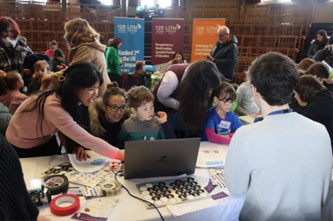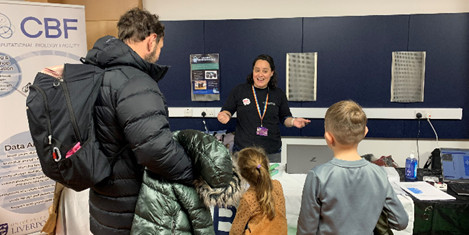For many children, their first exposure to programming is via the media where it will often be portrayed as something borderline arcane that ordinary people can't hope to understand. In addition, programmer characters are rife with stereotypes or lack any development. We want to change the perception of programming to something fun and accessible.
We applied for a Wellcome Trust grant for public outreach and engagement to purchase teaching aids to introduce children to programming. We targeted two groups, girls over 13 and children under 11.
Our teaching aids included small programmable computers known as BBC micro:bits and LEGO robots. The robots especially were something we'd hoped the children would find exciting. Once we developed our materials, we worked with museums that regularly host science events to deliver our materials.
Meet the Scientists
Our first event we trialled our materials with was the Meet the Scientists event regularly organised by the Faculty of Health and Life Sciences and hosted at the World Museum. We worked alongside several other fantastic and creative stalls to engage children with science.
At our stall, we explained how programming is essential in lots of walks of life. We also explained how robots are programmed remotely in space from the Earth. This then got them excited to meet our LEGO robot: Tricky. But before they could program Tricky, we had them practice on our micro:bits first. Both use a type of block-based programming very similar to SCRATCH. Block-based programming has been found to be effective in children as young as 5. Some children had encountered it in their schools and were excited to see how their skills could translate to something tangible. We had them turn their micro:bit into a dice roller that would show the face of the dice when it was shaken. We also had them create a name badge and a flashing heart animation.

When it came to the robot, many of them delighted in realising there was no upper limit to the number of rotations you could tell it to do. However, they were less happy when they realised the robot would then be stuck spinning forever! This taught them a valuable lesson about robots only being able to do precisely what you tell them (and also where the stop button was). Nevertheless, the children absolutely loved the robots, especially when they discovered they were made out of LEGO ('yes, really!' we'd say).
British Science Week and the VG&M
We employed a modified version of the same activity at the British Science Week event hosted at the Victoria Gallery & Museum. The theme of the event was 'connections' which was reflected strongly in our activities, the Bluetooth connection that allowed us to 'talk' to our robot, the connections between the blocks (both the physical LEGO and the programming blocks), and all the wiring and circuits in our LEGO hub and micro:bits.
This time we had more robots and more stickers! This was a relief as the robots continued to be hugely popular. We'd updated our activities to be more accessible based on our experience at Meet the Scientists. We also modified the build of our robots to include a colour sensor. This colour sensor allowed us to create all sorts of new and fun challenges, allowing our robots to respond to different colours and also react to lines of tape on the floor. We also created a route of black tape and set them the challenge of writing a program that could get the robot to trace a path across the tape.

This time two PhD students - Pimmy and Tei - volunteered to join us, and we really appreciated it because we were busy all day! We think they had as much fun learning block-based programming as the children did. It was also lovely to talk to their parents about how best to encourage programming in the future. We provided leaflets with free or cheap resources that could be used as teaching aids at home. Overall, it was an excellent experience for the children and us. We are looking forward to running similar activities at future events.
Back to: Computational Biology Facility
